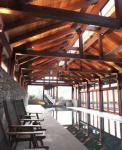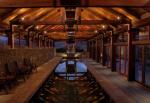Swimming Pool Complex
“I’ve got a small job for you.”
A chance airport meeting led Queenstown designer Graham Roebeck to one of the most challenging and rewarding projects to date, enclosing an existing pool and water feature in a slate tiled courtyard.
The hilltop pool is sheltered by landscaped walls and trees from the prevailing southerly, but the short Otago summers meant the pool, which is heated from rooftop solar collectors, also has a short operating season.
Background
Graham had worked in civil contracting for some years in Queenstown before commencing full time study toward an architectural qualification as a mature student.
On graduation and having worked for McDowell Architects in Invercargill he returned to Otago to work for Steve Mullan, director of Coast & Country Projects Ltd, This provided the opportunity to work on site on the large post & beam home that housed the pool and water feature. “There was nothing being built like this at the time,” say Graham, “and the chance to work on this project was an opportunity to good to miss. I’ve always been amazed that truckloads of materials arrive on site and are transformed by builders and tradesmen into a building. Working for (architect) Neil McDowell was wonderful, but understanding the building continuum and trades cooperation was a gap in my knowledge I needed to fill by seeing with my own hands.”
As a mouse pusher, labouring on site, Graham was welcomed by the carpenters and subbies - with a bit of good natured ribbing - the overwhelming sentiment being it should be compulsory for draughtsmen and architects to spend 3 or 6 months on the tools to learn the “real world” feasibility of drawn details. Steve became Graham’s mentor in the complex construction of the house; a hybrid of ancient carpentry, light commercial construction and high tech home automation.
The scribing of rustic rafters in beams and beams into posts, all sawn from recycled Australian hardwoods, was a revelation to Graham; that “off square” timber members with rounded gouges and other defects could be housed in without leaving a discernible gap.
Another eye opener was the lack of detailed drawings tradesmen often have to deal with- either for construction or aesthetics on architectural houses, with the myriad of complex junctions, angles and setouts for specified fittings.
“I gained a lot of respect for tradesmen, their love of the craft, and of building. That’s what makes a building beautiful, a team who bring their dedication to the project, that transcends a well designed or well built building. From the designer’s side, it makes it clear why some builders have preferred subcontractors – not just the subbies with a competitive tender.”
So some years after the house was finished, Graham was invited to complete the ‘small job.’
Since designing this building, some 5 years ago, several alternatives for solar heating have been developed. Creating unwashed areas is not recommended by MRM. Please refer to the article by Stuart Hayman, in Scope 29, on preferred installation of solar panels.
http://metalroofing.org.nz/frontend/issues_scope.cfm
Design
“The task wasn’t easy, with Services below the tiled courtyard and concealed pool infrastructure, so the first step was to identify the locations and design a grid for the post & beam structure that would work with these and the tiled planters” says Graham.
Steve Mullan said tech project and models proved invaluable but were so accurate they took away the sense of discovery as the building unfolded. The owner said “just like the model.”
The owner wanted an asymmetric clerestory roof to match the existing house, but Graham thought a symmetrical form with indirect light spilling from a lantern monitor directly over the pool would unite the materials of stone, water, glass and wood more effectively. Graham credits Steve Mullan with assisting
the design of the water feature annex.
“I made a cultural assumption that the clients would want a bold architectural statement, so had a much more dominant roof line that I thought would bring in the mountains and light more effectivelybut it’s form was quite aggressive and Steve knew the clients wouldn’t buy into it. That’s the reality of some projects- because of the longer time frame on large projects and ease of access the owners often get to know the builder far better than they get to know the designer and you need to respect these relationships.
Both options were presented at the concept stage and Steve’s insight proved correct and from here we were all on the same page.”
Graham says, “the project was a joy to work on, and simplified by several factors.”
- having worked with post & beam construction of the existing house under master carpenter Steve Mullan, knowing the properties of the hardwoods and the architectural language of the house and being entrusted with the design by the owners.
- a great working relationship with engineer Bernard Whitham
- having a 3D program (SketchUp Pro) to design the structure and each bracket around the 3 axes
- a great resource of Otago schist and recycled hardwoods and having experience in detailing these
- a great construction team who brought their own flair and ideas to the finished building
- Structural Integrity Ltd completed all documentation for the project from Resource and Building Consents through to shop drawings for the brackets and electronic files for plasma cutter.
Materials
The exterior cladding is glazed aluminium joinery, plaster & stone with all the exposed timber posts & beams wrapped in COLORSTEEL® sheet metal on cavity battens for a maintenance free finish. A photo voltaic array is fixed to the north face of the roof.
The interior has the South African slate tile flooring continuous from the courtyard, Smartwood aluminium joinery, exposed steel brackets, local schist and water. The timbers are those used in the existing house, salvaged Australian hardwoods resawn from South Island piers, bridges and telephone poles. The sarking and soffits are kiln dried Fijian Kauri and all timbers are treated with Dryden’s Wood Oil chosen for its aesthetics, performance and fungicidal properties. The stains was chosen to match those used in the existing house, and unified the raw colours of the sawn beams, which varied from straw yellow to deep red. The hardwoods were all sourced exclusively from Carl Livingstone at Ironwood, whose passion for this great resource has improved the architectural language of the Southern Lakes region.
Drainage
The existing drain is inside the pool house envelope, so a new strip drain was installed in front of the doors with sills raised on Cavibat plinths to allow them to open out against the fall, to allow any overflow to run harmlessly beneath to the existing drain and provide continuous trickle ventilation.
Brackets
Designing the brackets and connections in conjunction with engineer Bernard Whitham took weeks of designing and refining to find aesthetic solutions that would perform.
There are 202 hardwood members in the pool house connected by 432 brackets of 40 different types of between 8,10 &12mm thicknesses. These were all plasma cut to shop drawings and cutting lists prepared by Structural Integrity, and fabricated by Shotover Engineering Ltd.
Builder Steve Mullan used the SketchUp 3D model to identified each bracket and location, and the whole thing went up ‘like a Meccano set.’ Each of the 202 rustic hardwood members varied slightly in size, shape and appearance and required considerable skill and an artist’s eye to fit together.
Skillion Roof & Ventilation
A skillion roof over a heated swimming pool in an alpine area required serious research, expert advice and detailing. There was conflicting information by industry authorities, experts and published data over whether the roof should be ventilated or not.
Internal moisture is completely excluded from the envelope by a damp proof membrane behind the sarking. In the event that a roof leak or unidentified puncture of the membrane should introduce moisture into the skillion roof, a decision was made to ventilate the roof. Cavibat battens between the purlins and plywood roofing substrate allow air from discrete vents at the soffit and apex to ventilate the roof. In the 5 years since construction the expert opinion has aligned toward skillion roof ventilation and our decision has been vindicated.
Evaporative humidity is controlled by a motorised pool cover, and stack ventilation by motorised clerestory windows, and opening fanlights and bifold doors. The insulated pool cover is only withdrawn when the pool is in use. The system works so well there is a problem not with humidity and condensation but with
tangential timber shrinkage from further drying.
Roof Installer
Pavel Pecinka Craftsman Roofer fitted the roof. A Czech national, Pavel comes from a family of roofers and his knowledge of detailing and flashing has made him the roofer of choice for many builders of quality homes in Queenstown. His advice on improving the performance and aesthetics of flashings and routinely
doing the unachievable in sheet metal, opened eyes and minds of designers and tradesmen alike.
The 30 degree roof of 0.55mm COLORSTEEL® Standing Seam & Cap on Thermkraft 354 Building Paper fixed to 12.5mm H3.2 plywood substrate on Cavibat battens. Purlins are fixed to rafters w/ 50x50 Bowmac brackets, thru Protecto Wrap AntiFracture Membrane gaskets. Sisalation 425 double sided foil vapour barrier is used over Fijian Kauri sarking fixed to 200x75 hardwood rafters. R5.0 batts.
Ceiling penetrations were forbidden.
Photovoltaics
The 80 solar photovoltaic (PV) panels have a concealed fixing method designed and installed by Coast & Country Projects Ltd. The system was designed by Jason Campbell of Campbell Electric and not only supplies the house with its energy needs, with battery and generator backup in the event of power outage, but is a net generator of electricity and feeds surplus electricity back into the grid. The design and construction by Steve & Jason won an award by the Sustainable Electricity Association of New Zealand (SEANZ) for the Best Installation award of 2009.
Structural Integrity Ltd
An award winning boutique design & collaborative architectural practice in Queenstown, founded in 2005. Graham Roebeck is the principle designer working with architects and other consultants on a project by project basis. Current and previous work includes sculpture, film set design, contract 3D modelling, light
commercial buildings, significant residential alterations, new builds, and Jack’s Point residences. Structural Integrity clients are equal mix of Queenstown locals and remote national or international clients and accordingly their projects vary in the vastly different historic locations of Arrowtown and Zanzibar.
Design projects have included spacecraft and historic buildings for a heritage architect; co- designing a modern church, blue sky design competitions for Guggenheim NY and a tropical island treehouse resort.
Graham Roebeck designed the iconic Beehive chair, which has received international recognition and is made to order by David Trubridge’s workshop in Hastings.
On sustainability Structural Integrity take a more holistic approach. Our role has always been to try to find a response that honours the site for generations to come, using the best technology available to find the best efficiencies, using quality materials with a low environmental impact. We achieve sustainability by good stewardship, careful analysis and ongoing improvement.
“Architecture… is no less a weaving and a fabric than the trees are. There must be some kind of house that would belong to that hill, as the trees and the





